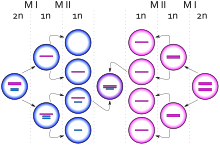User:Perezcinthya09/sandbox
Klinefelter Syndrome

Klinefelter syndrome or Klinefelter's syndrome, also known as XXY result which appears in male(XY)organism. This term is to describe how males have an extra X chromosome in almost all of their cells in the body. The normal human karyotype for males is illustrated as XY, for a total of 46 chromosomes, meanwhile Klinefelter syndrome causes the victim to contain in total of 47 chromosomes. Females contain the set of two X's (XX) , rather than having just one X and one Y. Due to the extra chromosome individuals with this syndrome are referred as "XXY males", or "47,XXY males.
Klinefelter syndrome is named after Dr. Henry Klinefelter who first discovered the symptoms and discoveries found in males with an extra X.
This chromosome constitution (karyotype) only appears in every one out 500 births. Although it is very common people say it is very rare to detect it due to no symptoms or differences in the lifestyle of the male. If physical symptoms are identify they are usually develop during puberty development , or other wise known when the male is a teenager.
This syndrome can be not only be found in human males but in mice as well.
Stages of Klinefelter's syndrome
Babies who are born with this syndrome, they are often associated with having weak muscles and little strength. They will be develop much slower in physical activities such as crawling or walking much more late than normal infants. By the age of four , XXY males can be seen as much taller than normal toddlers but have less muscle control or coordination. As they enter puberty, XXY males seem to develop less testosterone which can be the leading causes of having less facial hair, body hair, muscles and have wider hips. They also show symptoms of less energy, bigger breast and weaker bones. As they grow to adulthood they just grow taller and develop certain health problems such as breast cancer, tooth decay, heart problems, vein disease and several other severe disorders.
Reproduction
XXY males can have a normal life just like any other human being. They are able to have sexual reproduction as well but can only reproduce little or no sperm at all. About 95 percent to 99 percent of XXY males are infertile due to their reproduction system not functioning correctly to develop sperm.
Causes


This syndrome is due to the nondisjunction event during meiosis I (gametogenesis). The X and Y chromosome fail to separate during this cell division stage which cause the sperm to have two expressions and then it fertilizes into the Ova (female reproduction cell). This causes for the XXY karyotype expression which occurs in 1 out of 500 males.
Another theory is said that in the female reproduction system, in the cell cycle in which the egg goes through as well fails and ends up not diving correctly. This causes for the egg to contain the karyotype expression of XX and then gets fertilized with a sperm which only contains one Y expression.
Diagnosis
Only about 10% of cases are detected due to the phenotype symptoms being very visual or noticeable. These first features appeared in early childhood, but more frequently puberty. Despite the presence of small reproductive system seen in the male, only 25% of the affected males are recognized as having Klinefelter syndrome at puberty. Only 25% received their diagnosis in late adulthood: about 64% affected individuals are never recognized due to the little syndromes they can have. Often the diagnosis is made accidentally as a result of examinations and medical visits for reasons not linked to the condition.
Treatment
Their is no advance technology in order to reverse or take away the genetic variation. Often individuals with this syndrome get surgeries which allow them to get rid of breast or such other factors in order for them to be more comfortable with their bodies. They can be given Testosterone in order for hormones to be developed and muscles can get bigger in size.
"By 2010 over 100 successful pregnancies have been reported using IVF technology with surgically removed sperm material from males with Klinefelter syndrome"
References
1.Cummings, Michael R. (2011) "Human Heredity Principals and Issues" , 6.6 Aneuploidy of the Sex Chromosomes , Klinefelter syndrome (47, XXY) pg.137[1]
3.Saavedra-Castillo E, Cortés-Gutiérrez EI, Dávila-Rodríguez MI, Reyes-Martínez ME, Oliveros-Rodríguez A (February 2005). "47,XXY female with testicular feminization and positive SRY: a case report". J Reprod Med 50 (2): 138–40.</ref>
- ^ 2.Herlihy AS, McLachlan RI, Gillam L, Cock ML, Collins V, Hallpmiday JL (July 2011). "The psychosocial impact of Klinefelter syndrome and factors influencing quality of life". Genet. Med. 13 (7): 632–42.

